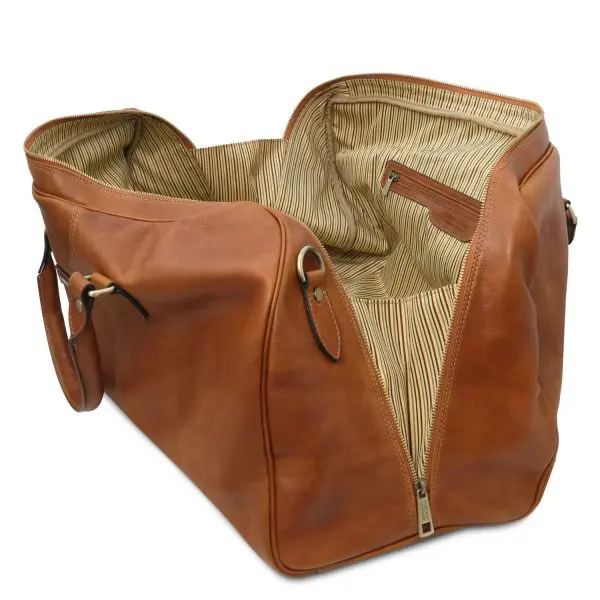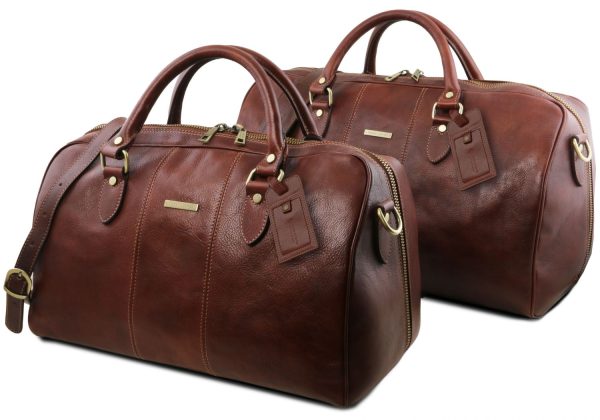All About Leather
Is a Duffle Bag Considered a Carry-On or Personal Item?
Is a duffle bag considered a carry-on or personal item? That is the question worth millions, or maybe not. But it’s nonetheless important for travelers and their preparation for any journey by air. It’s important to be certain whether or not your duffle bag will fit into the overhead compartment, or even better, under the seat in front of you. It’s confusing, and we are totally on board with you. Making a mistake of such magnitude might leave you few bucks shorter, and no one wants to give their hard-earned money to the airline moguls just to bring a few extra items. With this article, we will try to provide a clear and detailed guide regarding duffle bags and air travel, where and how will you be able to combine them in order to have a lovely overall experience.
Definition of Terms
The first step would be to identify what are duffle bags. You can learn about it in greater detail here. Its a quick and simple article providing the definition with some examples.
Once we have the definition covered, and we really are talking about the same thing, then we can move on to understanding the distinction between ‘carry-on’ and ‘personal item’, which is crucial in air travel. So, without further ado, let’s dive into it.
Carry-On:
- A small suitcase or bag allowed inside the plane’s cabin.
- Stored in the overhead bin.
- Subject to size restrictions, often not exceeding 22″ (56 cm) in length, 14″ (36 cm) in width, and 9″ (23 cm) in height (varies by airlines, but typically not by much).
- Intended for larger essentials and clothing, with limited liquid allowances.
Personal Item:
- A smaller bag, such as a purse, a laptop bag, or a small backpack.
- Must fit under the seat in front of the passenger.
- Faces more strict size limits compared to carry-ons, but in general, an average backpack of 14 x 18 x 8 inch (36 x 46 x 20 cm) dimensions fits just right.
- Typically used for valuables and items needed during the flight.
These definitions are key to understanding how to pack and what to expect in terms of luggage allowance, impacting both the cost and convenience of your journey.
Overview of Airline Policies on Luggage
Airline policies on luggage, particularly regarding carry-ons and personal items vary somewhat, but are not all that much different.
Some airlines don’t even allow free carry-on bags, encouraging travelers to purchase some sort of package deals that include them. Therefore, you should double check in any case.
General Carry-On Policies:
- Most airlines permit one carry-on bag per passenger.
- Size limits are generally around 22 x 14 x 9 inch (56 x 36 x 23 cm), but these dimensions can vary. For example, some budget airlines have more restrictive limits.
- Weight limits also differ, with some airlines imposing strict guidelines (often around 15 to 22 pounds (6-10 kg)), while others may not specify a weight limit.
- Overhead bin space is on a first-come, first-served basis, leading to gate-checking of carry-ons on full flights.
General Personal Item Policies:
- Airlines typically allow one personal item in addition to a carry-on.
- This item must fit under the seat, with common size limits being around 18 x 14 x 8 inch (36 x 46 x 20 cm), though this can vary.
- Ideal for essentials like a purse, small backpack, or laptop bag.
Variations Among Airlines:
- Policies can differ widely among carriers. Luxury and full-service airlines tend to be more lenient, while budget airlines might have stricter rules and additional fees.
- Some airlines have unique specifications, like special allowances for certain items (e.g., diaper bags, medical devices).
Travelers should be aware of these general guidelines, but must check with their specific airline for exact requirements. This step is crucial to avoid unexpected fees or repacking at the airport. It becomes especially important to double check if you travel with cheap airlines as their rules are strict and fees are high.
Duffle Bags as Carry-On Luggage
Determining whether a duffle bag can serve as carry-on luggage involves considering its size, shape, and practicality within the confines of airline regulations:
Size Compatibility:
- The key factor is whether the duffle bag fits within the airline’s size limits for carry-ons. Check the size limits above.
- Duffle bags are often flexible, especially if they are leather duffle bags. They can be molded to fit in overhead bins, but this flexibility also means they can easily exceed size limits if overpacked.
Shape and Accessibility:
- Unlike rigid suitcases, duffle bags can adapt to the irregular shape of overhead compartments.
- Their soft structure and variety of designs provides with some flexibility.
Practical Considerations:
- When using a duffle bag as a carry-on, consider the options of carrying it, especially if it’s larger in size. Go for a duffle with comfortable shoulder straps or wheels. But take into consideration that duffle bags with wheels on them will be much less flexible and might be looked at as luggage rather than carry-on.
- For frequent travelers, a duffle bag with durable materials is essential to enjoy the traveling experience. Therefore, going with leather duffle bag might be a wise option.
In conclusion, while many duffle bags are suitable as carry-on luggage, it’s crucial for travelers to consider their specific dimensions, design features, and the policies of the airline they are flying with.
Duffle Bags as Personal Items
While less common than using them as carry-ons, duffle bags can also qualify as personal items. Some conditions must be met, however.
Size Constraints:
- The critical factor is whether the duffle bag can fit under the seat in front of you. Therefore, check the size of your bag and see if they are under the allowed limits mentioned above.
- Due to these size restrictions, only small to medium-sized duffle bags are likely to qualify as personal items. Bigger ones, and especially, the ones with wheels on them, most likely be treated as a regular luggage.
Design and Functionality:
- A duffle bag intended as a personal item should be compact yet functional. It should have enough compartments for easy access to travel essentials like a passport, wallet, or electronics.
- The bag’s design should allow it to be comfortably placed under the seat without obstructing legroom.
This leather duffle bag below is the perfect example of a personal item, that meets size and design requirements:

You can check it out and buy it HERE.
Practical Usage:
- Travelers choosing to use a duffle bag as a personal item usually do so to maximize their carry-on allowance. This strategy is great for those who don’t want to overspend on regular check-in luggage.
- It’s essential to keep its size and weight once packed.
In summary, while duffle bags can be used as personal items, their suitability largely depends on their size and the specific airline’s policies. Travelers should carefully consider these factors to ensure a smooth and compliant travel experience.
Tips for Traveling with a Duffle Bag

Traveling with a duffle bag requires strategic packing and an understanding of airline policies. Here are some tips to ensure a lovely travel experience:
Check Airline Specifications:
- Before packing, confirm the size and weight restrictions for carry-on and personal items with your specific airline. This step is crucial to avoid unexpected repacking or fees at the airport.
Maximize Space Efficiently:
- Utilize packing cubes or compression bags to organize items and save space. This is especially useful in duffle bags, which can become disorganized due to their flexible structure. However, if you are to use compression bags, make sure you keep an eye out on a weight limit.
- Roll clothes instead of folding to maximize space and reduce wrinkles.
Balance Weight and Accessibility:
- Distribute weight evenly to make the bag easier to carry or stow.
- Place items you might need during the flight (like headphones or a book) in easily accessible pockets or at the top of the bag.
Consider Durability and Comfort:
- Choose a duffle bag made from durable materials.
- If the bag is large or heavy, consider a duffle with shoulder straps.
Be Prepared for Security Checks:
- Pack liquids and electronics in a way that they can be easily removed during security screening.
- Keep travel documents and IDs in a readily accessible pocket.
Use a Backup Plan:
- In case the overhead bins are full, be prepared to check your duffle bag at the gate. Pack valuables and essentials in a smaller bag that can be removed if needed.
By following these tips, travelers can enjoy the flexibility and convenience of using a duffle bag, while also adhering to airline guidelines and ensuring a stress-free journey.
Conclusion
In conclusion, whether a duffle bag is considered a carry-on or a personal item largely depends on its size, the specific airline’s policies, and how you pack it. Therefore, it’s never an easy yes or no answer.
While duffle bags offer flexibility and convenience, they also require mindful packing and an awareness of airline restrictions. By understanding these nuances, travelers can make the most out of their duffle bags, ensuring a hassle-free experience at the airport. Always remember, the key to a smooth journey is in the preparation – checking airline policies and packing smartly are essential steps in this process.
You can also check out our leather duffle bag collections for men and women. We hold a large and exclusive stock of full-grain leather duffle bags that will accompany you through any voyage you will undertake. Our product descriptions clearly display the dimensions, therefore, please make sure to look at them closely, especially if you are looking for a duffle bag that you’d use as a personal item.
If you found the article helpful, follow us on Facebook and Instagram for more useful and practical information.
Frequently Asked Questions (FAQs) about Duffle Bags as Carry-On or Personal Items
Can a duffle bag be used as a carry-on?
- Yes, a duffle bag can be used as a carry-on if it meets the airline’s size restrictions for overhead bin space, typically around 22 inches by 14 inches by 9 inches, though this can vary by airline.
Are there size limitations for duffle bags as personal items?
- Yes, when using a duffle bag as a personal item, it must fit under the seat in front of you. The common size limit for personal items is about 18 inches by 14 inches by 8 inches, but this varies among airlines.
Do airlines have different policies for carry-ons and personal items?
- Absolutely. Airline policies on luggage size and weight can vary significantly. It’s essential to check with your specific airline for their carry-on and personal item guidelines.
What should I consider when choosing a duffle bag for air travel?
- Consider the size to ensure it fits airline restrictions, the bag’s material and durability for frequent travel, and features like compartments for organization and straps or wheels for easy transport.
How can I maximize space in my duffle bag?
- Use packing cubes or compression bags to organize and condense items. Rolling clothes instead of folding them can also save space and reduce wrinkles.
Is it better to use a duffle bag as a carry-on or a personal item?
- This depends on your travel needs and the specific airline’s policies. A duffle bag as a carry-on is suitable for larger items and clothing, while as a personal item, it’s ideal for essentials and valuables.
What happens if my duffle bag is too big to be a carry-on?
- If your duffle bag exceeds the airline’s size limits for carry-ons, you may have to check it in, potentially incurring additional fees.
Can I bring a duffle bag in addition to a carry-on suitcase?
- Yes, if the duffle bag fits the size criteria for a personal item, you can bring it along with a carry-on suitcase.
How do I prepare my duffle bag for security checks?
- Pack liquids and electronics in an easily accessible manner for quick removal during security screenings. Keep travel documents and IDs in a readily accessible pocket.
What if the overhead bins are full and I have a duffle bag as a carry-on?
- Be prepared to check your duffle bag at the gate. It’s wise to pack valuables and essentials in a smaller bag that can be removed and kept with you if necessary.


